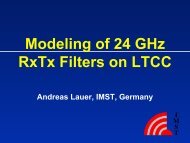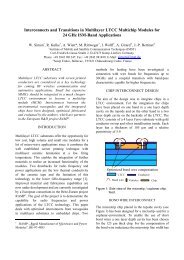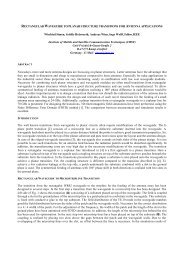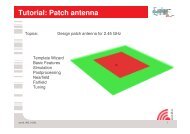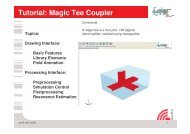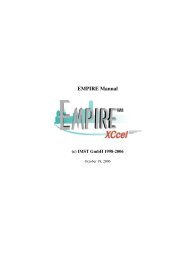A Compact Single/Dual-Band Printed Inverted-F Type Antenna ...
A Compact Single/Dual-Band Printed Inverted-F Type Antenna ...
A Compact Single/Dual-Band Printed Inverted-F Type Antenna ...
Create successful ePaper yourself
Turn your PDF publications into a flip-book with our unique Google optimized e-Paper software.
A <strong>Compact</strong> <strong>Single</strong>/<strong>Dual</strong>-<strong>Band</strong> <strong>Printed</strong> <strong>Inverted</strong>-F <strong>Type</strong> <strong>Antenna</strong> Structure<br />
A. Rennings, M. Rauf, P. Waldow and I. Wolff<br />
Department of Engineering (ATE), Duisburg-Essen University<br />
Bismarckstr. 81, 47048 Duisburg, Germany<br />
renny@ate.uni-duisburg.de<br />
Abstract: In the first part of the paper a compact version of a printed inverted-F type antenna is<br />
presented. The compactness is achieved by placing the necessary matching line at the side of the<br />
feeding line with the main radiator - not at the other side of the feeding line, as for the ordinary IFA.<br />
Another advantage is the possibility of an additional λ/2-resonance along the matching line, which is<br />
connected to the ground-plane over a via. By using the two first resonances a dual-band antenna can be<br />
designed - that has been done in the second part of this paper. Our novel antenna structure is well<br />
suited for small mobile communication devices or PC-cards operating within the ISM 2.4 and 5 GHz<br />
bands. Bluetooth and the WLAN standards IEEE 802.11 a, b, g are the most important applications<br />
within the above mentioned frequency bands. The antenna structures have been optimized using a<br />
commercial FDTD tool. These designs have been validated with measurements on fabricated<br />
prototypes - together with additional FEM-simulations.<br />
Keywords: printed dual-band antenna, inverted-F antenna, WLAN<br />
1. Introduction<br />
A lot of integrated antennas for mobile communication devices are based on the planar inverted-F<br />
antenna (PIFA) or the integrated inverted-F antenna (I-IFA) - sometimes called printed inverted-F<br />
antenna [1], since these antenna types are compact and have a sufficient bandwidth for most<br />
applications. So far in mobile phones PIFA-based concepts are mostly deployed for GSM standards,<br />
because there is not enough space available on the printed circuit board (PCB) for a printed multi-band<br />
antenna. On the other hand, in cell phones with the Bluetooth feature a printed IFA at the side or<br />
bottom edge of the multi-layer substrate is used as BT antenna, operating in the 2.4 GHz ISM band.<br />
Here it is important to use as less area on the PCB as possible for this antenna, since manufacturers<br />
need the limited space on the PCB for the other electronics.<br />
VH<br />
VH<br />
GROUNDPLANE<br />
Fig. 1: Ordinary integrated inverted-F antenna (IIFA) Fig. 2: <strong>Compact</strong> Bended-h antenna (BhA)
Another field of application for the presented antenna structures are wireless local area networks<br />
(WLANs). WLANs are becoming increasingly popular, since they provide high speed connectivity<br />
and easy access to networks without requiring wiring. Most of the current WLAN products being<br />
deployed are based on the IEEE 802.11b standard operating at 2.4 GHz with data delivery rates of up<br />
to 11 Mbps. WLAN devices with IEEE 802.11a operate within the 5 GHz ISM band. This standard<br />
provides more bandwidth and channels than the first one, resulting in data rates up to 54 Mbps. There<br />
are single and dual-band WLAN PCMCIA-cards available for laptop computers. Alternatively, for<br />
PCs in general a external WLAN card, that is connected to the computer via the USB port, can be used<br />
(USB stick WLAN card). Other upcoming applications are PDAs or Pocket PCs with the WLAN<br />
feature - either with an additional tiny card (wireless compact-flash card) or with a directly integrated<br />
WLAN module including the antenna. So far only single-band devices for IEEE 802.11b are on the<br />
market, except the PCMCIA card type. For all the above mentioned WLAN applications it is<br />
important to have a very compact antenna that needs minimal space on the board. Additionally, for<br />
dual-band operation it is necessary to have a multi-resonant antenna.<br />
2. FDTD/FEM-Simulations and Measurements on Prototypes of <strong>Single</strong>-<strong>Band</strong> <strong>Antenna</strong>s<br />
Our first objective is the design of a compact printed antenna for the ISM 2.4 GHz band intended<br />
for Bluetooth or WLAN (802.11b) applications. In Fig. 2 our compact antenna structure is depicted.<br />
Because of its shape, the structure is called bended-h antenna (BhA). During the optimization it turned<br />
out that the structure in Fig. 3 has the best bandwidth for single-band operation within the mentioned<br />
ISM band. Here the matching line is located above the ground plane - this special antenna is called<br />
single-band BhA.<br />
VH<br />
GROUNDPLANE<br />
<strong>Antenna</strong> IIFA BhA<br />
R1 24 22.5<br />
M1 7 22.5<br />
H1 5 5<br />
W (Ant.) 1 1<br />
W (Feed) 1.55 1.55<br />
Fig. 3. <strong>Single</strong>-band BhA Tab. 1: Dimensions in mm of IIFA and BhA<br />
The 3D FDTD field simulator EMPIRE [3] was used to optimize the structure in terms of<br />
bandwidth and resonance frequency. Prototypes of an ordinary integrated IFA (Fig. 4) and our bendedh<br />
antenna (Fig. 5) have been built to verify the FDTD simulations. The dimensions for these antennas<br />
are given in Tab. 1. A board size of 50 mm x 50 mm was used. The substrate parameters were<br />
RT/duroid 5870 with an εr of 2.33 and a thickness of 508 µm (20 mil). As mentioned above, the BhA<br />
structure needs less area on the board than the ordinary IIFA, but reaches nearly the same bandwidth<br />
and matching values as the FDTD/FEM simulations and measurements in Fig. 8 up to Fig. 10 indicate.<br />
The FEM simulations have been carried out with the software HFSS [4]. The HP NWA 8722C has<br />
been used for the measurements on various prototypes.
Fig. 4: Ordinary integrated inverted-F antenna (IIFA)<br />
Fig. 5: BhA prototype w/ SMA connector<br />
Fig. 6: <strong>Single</strong>-band BhA (thin version) Fig. 7: <strong>Single</strong>-band BhA (thick version)<br />
We have built a few prototypes of the single-band BhA. The results of two of them – the thin version<br />
of Fig. 6 and the thick version of Fig. 7 – are displayed in the diagramms Fig. 9/10.<br />
S11 [dB]<br />
0<br />
-5<br />
-10<br />
-15<br />
-20<br />
-25<br />
-30<br />
-35<br />
-40<br />
Fig. 8: best result for the ordinary IIFA<br />
-45<br />
2,0 2,1 2,2 2,3 2,4 2,5 2,6 2,7 2,8 2,9 3,0<br />
f [GHz]<br />
Empire<br />
HFSS<br />
Measurement
S11 [dB]<br />
S11 [dB]<br />
0<br />
-5<br />
-10<br />
-15<br />
-20<br />
-25<br />
-30<br />
0<br />
-5<br />
-10<br />
-15<br />
-20<br />
-25<br />
-30<br />
-35<br />
Fig. 9: Return Loss of <strong>Single</strong>-band <strong>Antenna</strong> (thin version)<br />
-35<br />
2,0 2,1 2,2 2,3 2,4 2,5 2,6 2,7 2,8 2,9 3,0<br />
f [GHz]<br />
Empire<br />
HFSS<br />
Fig. 10: Return Loss of <strong>Single</strong>-band <strong>Antenna</strong> (thick version)<br />
Measurement<br />
Empire<br />
HFSS<br />
Measurement<br />
2,0 2,1 2,2 2,3 2,4 2,5<br />
f [GHz]<br />
2,6 2,7 2,8 2,9 3,0
3. FDTD/FEM-Simulations and Measurements on Prototypes of <strong>Dual</strong>-<strong>Band</strong> <strong>Antenna</strong>s<br />
In the open literature there are less papers on printed multi-band antennas, compared to the many<br />
publications on multi-band PIFAs. In [2] a so-called stacked IFA for dual-band operation is presented.<br />
The PCB-area needed for this antenna structure is quite large, due to its stacked assembly. Our dualband<br />
antenna presented in the following has a more compact design. The qualitative outline of the<br />
structure is shown in Fig. 2 and is called dual-band bended-h antenna (dual BhA). Our objective in this<br />
section is to design a compact dual-band antenna for WLAN operation within the ISM 2.4 and 5 GHz<br />
bands. The matching line (secondary radiator) with its dimensions M1 and M2 (see Fig. 2) is located<br />
in the reactive near-field of the main radiator, yielding a coupling between main and secondary<br />
radiator. The bandwidth for the 2.4 GHz resonance of the main radiator is reduced compared to the<br />
single-band BhA of section 2 – in this case there is just a little coupling between main radiator and the<br />
matching line above the ground-plane. But a bandwidth of around 100 MHz is sufficient for the lower<br />
ISM band from 2.40 to 2.4835 GHz. For the IEEE 802.11a standard altogether three subbands exists.<br />
The first subband is from 5.15 to 5.25 GHz and it allows up to 16 dBm transmitting RF power. The<br />
second one is from 5.25 to 5.35 GHz with 23 dBm maximum power, and the third one, mainly<br />
intended for outdoor applications, is from 5.725 to 5.825 GHz with 29 dBm max. power. The overall<br />
BW is therefore 675 MHz. The length and position of the secondary radiator has been optimized with<br />
EMPIRE to have approx. 100 MHz of bandwidth in the lower ISM band and close to 675 MHz for<br />
the three subbands within the 5 GHz ISM band. In Fig. 11 one prototype of the dual-band BhA on<br />
duroid substrate is depicted. In the next figure the measurement setup with an non-soldered SMA<br />
connector is displayed. The return loss results are shown in Fig. 13. The agreement between the two<br />
simulations methods FDTD and FEM and also with the measurement results is very good – especially<br />
for the lower ISM band. The S11-parameter displayed in the Smith Chart gives even more insight to the<br />
electrical behavior of the antenna. In Fig. 14/15 the results of Empire and HFSS within the Smith<br />
Chart are presented.<br />
Fig. 11: Section with dual-band BhA Fig. 12: Measurement setup for dual-band BhA
S11 [dB]<br />
0<br />
-5<br />
-10<br />
-15<br />
-20<br />
-25<br />
-30<br />
-35<br />
Fig. 13: <strong>Dual</strong>-band <strong>Antenna</strong> on RT/duroid 5870<br />
Empire<br />
HFSS<br />
Measurement<br />
2,0 2,5 3,0 3,5 4,0 4,5 5,0 5,5 6,0 6,5<br />
f [GHz]<br />
Fig. 14: S11 within Smith Chart simulated with FDTD Fig. 15: S11 within Smith Chart simulated with FEM
After finsihing the design on RT/duroid we made a redesign on FR-4. An εr of 4.5 was assumed for the<br />
FDTD simulations. Fig. 16 is a photograph of one prototype. The agreement between FDTD-, FEMsimulation<br />
and measurement in Fig. 18 was surprisingly good, since the material parameters of FR-4<br />
underlie high tolerances.<br />
An efficiency measurement has not been done by us, but we expect issues, especially for the 5 GHz<br />
ISM band. FR-4 might be used up to 2.5 GHz - but not for higher frequencies. For the future we will<br />
use a better material, like Rogers RO 4003.<br />
S11 [dB]<br />
Fig. 16: Cut-out of dual-band antenna on FR-4 Fig. 17: Measurement setup with antenna on FR-4<br />
0<br />
-5<br />
-10<br />
-15<br />
-20<br />
-25<br />
-30<br />
-35<br />
Fig. 18: Return Loss of <strong>Dual</strong>-band <strong>Antenna</strong> on FR4<br />
Empire<br />
HFSS<br />
Measurement<br />
2,0 2,5 3,0 3,5 4,0<br />
f [GHz]<br />
4,5 5,0 5,5 6,0
Finally, we present our simulation results in terms of current distributions at the two first resonance<br />
frequencies. In Fig. 19/20 the current density |J(x,y)| at the front side of the substrate with the antenna<br />
structure (top) and at the back side with the ground plane (bottom) are depicted. At a frequency of 2.5<br />
GHz there is a matched λ/4-resonance along the main radiator. For a frequency of 5.5 GHz there is a<br />
λ/2-current distribution along the matching line (secondary radiator). In between of the two surface<br />
plots the FDTD model can be seen in the two figures.<br />
Fig. 19: Simulated current density |J(x,y)| @ 2.5 GHz<br />
in top and bottom layer (ground plane)<br />
4. Conclusions<br />
In this paper a compact single/dual-band antenna structure, printed on a substrate, was presented.<br />
The design is compact, cost-effectively and precisely to manufacture. The single-band antenna<br />
structure presented in the second section has a compact design compared to the ordinary printed IFA<br />
and has a similar performance in terms of bandwidth and matching. It might be a candidate for mobile<br />
communication devices with Bluetooth or IEEE 802.11 b/g WLAN operation. The second antenna<br />
presented is a very compact dual-band antenna for the 2.4 and 5 GHz ISM bands and might be used for<br />
dual-band WLAN operation for the standards IEEE 802.11 a, b/g.<br />
References<br />
Fig. 20: Simulated current density |J(x,y)| @ 5.5 GHz<br />
in top and bottom layer (ground plane)<br />
[1] M. Ali and G. Hayes, "Analysis of integrated inverted-F antennas for Bluetooth applications",<br />
2000 IEEE AP-S Conference on <strong>Antenna</strong>s and Propagation for Wireless Communication,<br />
Massachusetts, pp. 21-24, Nov. 2000.<br />
[2] K.-L. Wong, "Planar <strong>Antenna</strong>s for Wireless Communications", pp. 226 – 228, John Wiley & Sons,<br />
Inc., Hoboken, New Jersey, 2003.<br />
[3] IMST GmbH, “User manual for the 3D EM time-domain simulator Empire”,<br />
www.empire.de/empire.pdf, June 2002.<br />
[4] Agilent, HFSS - User and reference manual



